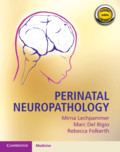Book contents
- Perinatal Neuropathology
- Perinatal Neuropathology
- Copyright page
- Contents
- Preface
- Acknowledgments
- Abbreviations
- Section I Techniques and Practical Considerations
- Section 2 Human Nervous System Development
- Section 3 Stillbirth
- Section 4 Disruptions / Hypoxic-Ischemic Injury
- Section 5 Malformations
- Section 6 Perinatal Neurooncology
- Section 7 Spinal and Neuromuscular Disorders
- Section 8 Eye Disorders
- Section 9 Infections: In Utero Infections
- In Utero Infections
- Chapter 57 Congenital Viral, Bacterial, and Parasitic Infections
- Peri- and Postnatal Infections
- Section 10 Metabolic / Toxic Disorders: Storage Diseases
- Section 11 Forensic Neuropathology
- Appendix 1 Technical Considerations in Perinatal CNS
- Index
- References
Chapter 57 - Congenital Viral, Bacterial, and Parasitic Infections
from In Utero Infections
Published online by Cambridge University Press: 07 August 2021
- Perinatal Neuropathology
- Perinatal Neuropathology
- Copyright page
- Contents
- Preface
- Acknowledgments
- Abbreviations
- Section I Techniques and Practical Considerations
- Section 2 Human Nervous System Development
- Section 3 Stillbirth
- Section 4 Disruptions / Hypoxic-Ischemic Injury
- Section 5 Malformations
- Section 6 Perinatal Neurooncology
- Section 7 Spinal and Neuromuscular Disorders
- Section 8 Eye Disorders
- Section 9 Infections: In Utero Infections
- In Utero Infections
- Chapter 57 Congenital Viral, Bacterial, and Parasitic Infections
- Peri- and Postnatal Infections
- Section 10 Metabolic / Toxic Disorders: Storage Diseases
- Section 11 Forensic Neuropathology
- Appendix 1 Technical Considerations in Perinatal CNS
- Index
- References
Summary
Adverse neurological effects of maternal infection, in particular syphilis, on the developing fetus has been recognized for centuries (1). In 1971, Nahmius and coworkers proposed the acronym TORCH, in recognition of the fact that Toxoplasma gondii, rubella, cytomegalovirus, and herpes simplex virus infections could produce a similar spectrum of abnormalities (2). The acronym was later expanded to STORCH to include syphilis, with the “O” including others. In this chapter, we will address the maternal infections that can be associated with congenital brain damage.
- Type
- Chapter
- Information
- Perinatal Neuropathology , pp. 339 - 358Publisher: Cambridge University PressPrint publication year: 2021

